

The Nightmare in Fort Worth
Fort Worth is a city of 700,000 on the west side of the Dallas/Fort Worth Metroplex, with a combined population of over six million. It is sited on the Trinity River, which flows through northeast Texas to the Gulf of Mexico southeast of Houston.
A fort was built here in 1849, one of a line of forts proposed by General Worth to defend US territory from Mexicans and Indians. In Texas and American folklore, this is glorious history, a telling which avoids mention that the land was seized from Indians and Mexicans, and avoids talking about imperialism, arrogance, and racism.
Later cattle drives heading north to railheads in Kansas on the Chisholm Trail passed by Fort Worth. The railroad arrived in 1876, and Fort Worth became "cowtown", a major US stockyard centre. With the consequent economic and population growth, came corruption, crime and violence. The city had arrived.
Barnett Shale
Fast forward to the present. US energy policy and unprecedented energy prices have stimulated an intense North American hunt for more oil and gas. Natural gas is known to be in abundance in the Barnett Shale in north Texas, and also in shales in northeastern BC. Both places have experienced a phenomenal drilling and production boom.
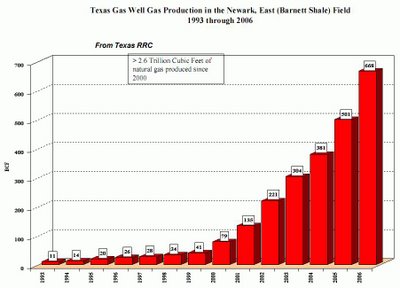 Click here for larger image. Click here for larger image. |
Same operators in BC
Wikipedia's entry on the Barnett Shale contains a variety of interesting maps and tables. The table listing the top ten operators shows company names like Devon, Encana and Burlington Resources. No surprise that these companies are also among the top producers in northeastern BC.
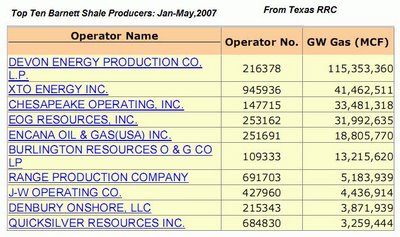 Click here for larger image. Click here for larger image. |
Not like producing conventional gas
Shale is a more challenging host for natural gas than conventional plays. Production is more expensive and has greater environmental impacts than conventional gas. With conventional gas, gas is retained underground under considerable pressure, and once a well is drilled into the substrate, gas essentially shoots out of the ground. At times, production can be enhanced by stimulation - fracturing the substrate ("fraccing"), a process whereby muds or fluids are forced down the well and into the host geology to break it up and increase the release of the entrapped gas. Fraccing materials are highly suspect by critics of the industry - companies like Halliburton sell patented and secret mixtures of chemicals, in a mix either of diesel or nitrogen. Industry claims it is all benign. But fraccing fluids are toxic, the use of water competes with other water uses, and fraccing can contaminate groundwater.
Fraccing has come into its own with shales, as the shale doesn't give up its gas easily - as with coalbed methane. Nearly continuous fraccing takes place. Of course, this is a dreamy situation for companies like Halliburton. Like a pharmaceutical company getting a society hooked on flu shots or tranquilizers or beta-blockers, our addiction to oil and gas has created a dependency on fraccing fluids.
With shale gas, horizontal drilling has become the preferred production method. A single vertical well is drilled, and at the desired depth, a number of horizontal laterals are then drilled away from the centre.
Drilling and fraccing in shales are water and energy intensive activities. Water use and greenhouse gas emissions produced are significantly greater than emissions from conventional production.
Drilling in the middle of Fort Worth
In BC, most drilling activity is some distance removed from residential areas, although coalbed methane threatens a number of towns, including Campbell River, Princeton, and Telkwa. In fact, conventional and coalbed methane activity is already commonplace in Hudson's Hope.
But it's nothing like what's happening in Fort Worth. The city sits right on a desirable chunk of the Barnett Shale, and the city government has leased over 2400 acres of public land to drilling operators. As you would expect, the city is divided: on the one side, the companies (mainly Chesapeake Energy), those who argue the city will benefit from the revenues and those who directly benefit from deals with the company, versus residents who are concerned about the livability, ecology, and safety of their homes and city.
This from the New York Times: "Under golf courses, schools, parks, libraries, airports and dozens of neighborhoods, some of the nationís leading independent energy companies are scouring the city in search of the best locations to recover one of the largest concentrations of natural gas in the United States."
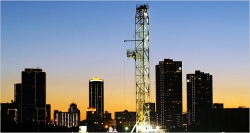 Drilling rig and the Fort Worth skyline, from the New York Times Drilling rig and the Fort Worth skyline, from the New York Times |
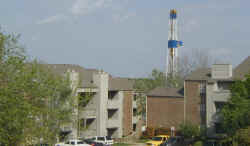 Havenwood Apartment Complex, Fort Worth. Havenwood Apartment Complex, Fort Worth. |
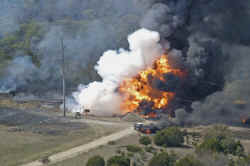 March 12, 2007 explosion west of downtown Fort Worth. March 12, 2007 explosion west of downtown Fort Worth. |
 Tommy Lee Jones promotes gas drilling in Fort Worth. Tommy Lee Jones promotes gas drilling in Fort Worth. |
Related reading
Barnett Shale
Wikipedia
http://en.wikipedia.org/wiki/Barnett_Shale
Blum Shale Maps
http://blumtexas.blogspot.com/
Fort Worth, Texas
Wikipedia
http://en.wikipedia.org/wiki/Fort_Worth
Rigs on the Skyline and Gas Far Below
Clifford Krauss, New York Times, 27-Oct-2006
http://www.nytimes.com/2006/10/27/business/27drilling.html
Fort Worth Flatulence
Eyes on Texas
http://durangotexas.com/eyesontexas/fortworth/barnettshale.htm